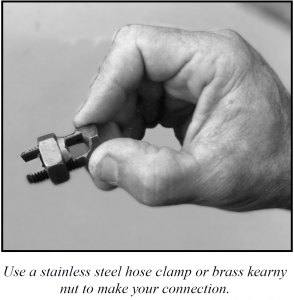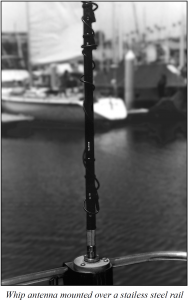To achieve the ultimate in long skywave range, you need an antenna system that is a minimum of 23 feet long tied into your automatic antenna tuner. The longer the antenna, the better!
For powerboats, your antenna will be a 2 or 3-piece, fiberglass whip. The fiberglass whip, on a powerboat, is mounted on the port or starboard side with an upper support bracket. It is fed with single wire GTO-15 that connects the whip to the nearby automatic antenna tuner. This whip is sufficient for most powerboats.
For sailboats, insulating one of the stays “in the clear” is the best way to achieve an antenna system that is between 30 feet and 70 feet long. An insulated backstay is the most popular choice. The insulators are put on by professional riggers. The rigger should place the top insulator at a point where it is about 3 feet from the mast. The bottom insulator, on a single backstay, is placed at eye level. Any lower and someone
might actually touch the hot part of the antenna. Any higher and it’s tough to service the connection point. Keep it at eye level.
On a split backstay, where the split is below the masthead, use three (3) insulators. The top and bottom insulators are installed on the side of the backstay to be used as the antenna. The other insulator should be placed near the top of the split leg as close to the Y as possible. This effectively takes the split out of the antenna system. Run the GTO-15 up the stay to a point above the lower insulator.
 Use a stainless steel hose clamp to make your connection. You can also make the connection with a brass kearny nut available at electrical houses. Make sure that there is a good contact between the GTO-15 single wire and the insulated stay. NEVER USE COAX! Use rigger’s tape to completely seal the connection, and at least once a year check your connection to insure it is making a good electrical contact with the stay.
Use a stainless steel hose clamp to make your connection. You can also make the connection with a brass kearny nut available at electrical houses. Make sure that there is a good contact between the GTO-15 single wire and the insulated stay. NEVER USE COAX! Use rigger’s tape to completely seal the connection, and at least once a year check your connection to insure it is making a good electrical contact with the stay.
On a ketch, you can insulate either the port or the starboard main stays, or you could insulate a mizzen stay and achieve good results. I like the mizzen stay better than the port or starboard stay, because it is more likely to be outside of and away from other riggins. Anytime you provide an antenna that is part of your rigging that is surrounded by other rigging, you lose valuable transmission and reception range. On sailboats, with all sorts of grounded rigging, your antenna must be outside of this rigging, and in the clear, to transmit and receive over long range.
If your insulated stay may come in contact with other metals, or could be touched by someone on deck, use rigger’s tape or plastic stay covers to keep it isolated. Always keep in mind that everyone on deck needs to stay away from your transmitting antenna when you are actually on the air with the microphone keyed. On receive, the antennas are harmless. But on transmit, new FCC rules require everyone stay clear of the radiating antenna.
Remember, where ever you install GTO-15 (a “hot” part of your antenna system) along a metal component of the vessel, you should cut any green bonding wire that connects that component to ground. If the backstay chain plate is bonded, cut the bonding wire to that chain plate. If you have installed GTO-15 next to a stanchion, that stanchion should be removed from the bonding system. This prevents that powerful SSB signal from going right back to ground rather than radiating from your antenna
 Pre-Tuned 6-Foot Whip
Pre-Tuned 6-Foot Whip
A pre-tuned 6-foot whip containing both ham and marine radio frequencies will work nicely on both powerboats and sailboats. The whip does not require an automatic antenna tuner, so what you pay for the whip will actually be less than what you would have paid for an automatic antenna tuner. Your range with the whip is about 30% less than you would get with an automatic tuner connected to a long antenna wire.
The Whip Must Be Mounted Over A Horizontal Stainless Steel Rail!
The whip cannot be mounted on wood, nor can it be mounted on fiberglass. These pre-tuned whips MUST be over a horizontal rail with at least 3 feet of surface area on each side of the whip.
For sailboats, the whip goes where you normally put the hibachi or outboard motor. Keep it away from the self-steering metal wind vane or wind generator.
On powerboats, the pre-tuned whip is placed over any horizontal rail, with the rail around the flying bridge most preferred. This gets the energy up and away from everyone down below. Remember, everyone must be at least 5 feet away from any transmitting high frequency antenna system.
The whip features plug-in “taps” to cause the antenna to self-resonate on specific marine radio or ham radio frequencies. Each tap point is marked in MHz for marine band, and meters for the ham band. You simply plug in the banana plug to the appropriate jack, and you are on the air with your self-tuned antenna system.
The self-resonant whip antenna gives good results up to a 3,000 miles range. But each time you switch from one marine MHz band to an other one, you must send someone out to the whip to tap into the appropriate band that you plan to operate on.